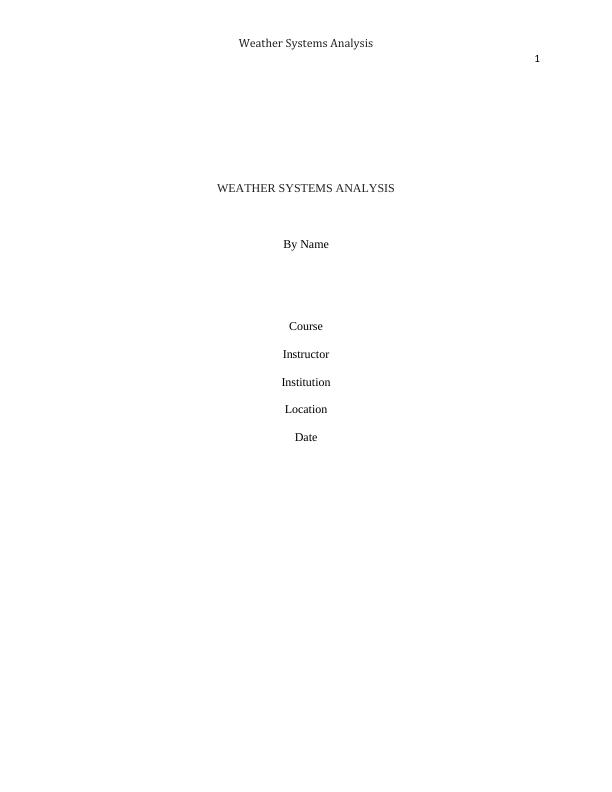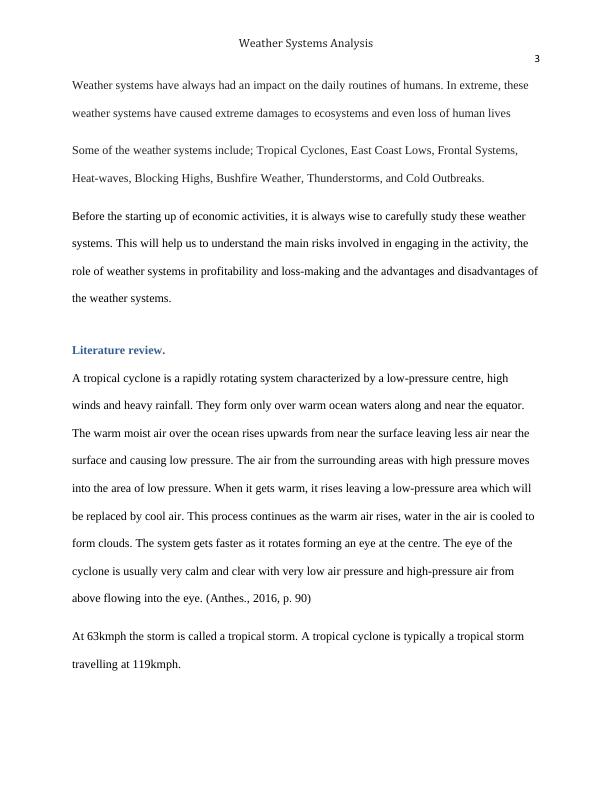Weather Systems Analysis
Added on 2023-01-19
10 Pages1800 Words94 Views
Weather Systems Analysis
1
WEATHER SYSTEMS ANALYSIS
By Name
Course
Instructor
Institution
Location
Date
1
WEATHER SYSTEMS ANALYSIS
By Name
Course
Instructor
Institution
Location
Date

Weather Systems Analysis
2
Contents
Weather Systems Analysis..............................................................................................................1
Introduction......................................................................................................................................3
Review.............................................................................................................................................3
Case study........................................................................................................................................4
Conclusion.......................................................................................................................................5
Bibliography....................................................................................................................................5
Introduction.
Weather is a set of specific conditions of the atmosphere which describe how hot or cold, wet or
dry, calm or stormy, clear or cloudy. The average of these weather conditions over a long
number of years is what makes up the climate.
2
Contents
Weather Systems Analysis..............................................................................................................1
Introduction......................................................................................................................................3
Review.............................................................................................................................................3
Case study........................................................................................................................................4
Conclusion.......................................................................................................................................5
Bibliography....................................................................................................................................5
Introduction.
Weather is a set of specific conditions of the atmosphere which describe how hot or cold, wet or
dry, calm or stormy, clear or cloudy. The average of these weather conditions over a long
number of years is what makes up the climate.

Weather Systems Analysis
3
Weather systems have always had an impact on the daily routines of humans. In extreme, these
weather systems have caused extreme damages to ecosystems and even loss of human lives
Some of the weather systems include; Tropical Cyclones, East Coast Lows, Frontal Systems,
Heat-waves, Blocking Highs, Bushfire Weather, Thunderstorms, and Cold Outbreaks.
Before the starting up of economic activities, it is always wise to carefully study these weather
systems. This will help us to understand the main risks involved in engaging in the activity, the
role of weather systems in profitability and loss-making and the advantages and disadvantages of
the weather systems.
Literature review.
A tropical cyclone is a rapidly rotating system characterized by a low-pressure centre, high
winds and heavy rainfall. They form only over warm ocean waters along and near the equator.
The warm moist air over the ocean rises upwards from near the surface leaving less air near the
surface and causing low pressure. The air from the surrounding areas with high pressure moves
into the area of low pressure. When it gets warm, it rises leaving a low-pressure area which will
be replaced by cool air. This process continues as the warm air rises, water in the air is cooled to
form clouds. The system gets faster as it rotates forming an eye at the centre. The eye of the
cyclone is usually very calm and clear with very low air pressure and high-pressure air from
above flowing into the eye. (Anthes., 2016, p. 90)
At 63kmph the storm is called a tropical storm. A tropical cyclone is typically a tropical storm
travelling at 119kmph.
3
Weather systems have always had an impact on the daily routines of humans. In extreme, these
weather systems have caused extreme damages to ecosystems and even loss of human lives
Some of the weather systems include; Tropical Cyclones, East Coast Lows, Frontal Systems,
Heat-waves, Blocking Highs, Bushfire Weather, Thunderstorms, and Cold Outbreaks.
Before the starting up of economic activities, it is always wise to carefully study these weather
systems. This will help us to understand the main risks involved in engaging in the activity, the
role of weather systems in profitability and loss-making and the advantages and disadvantages of
the weather systems.
Literature review.
A tropical cyclone is a rapidly rotating system characterized by a low-pressure centre, high
winds and heavy rainfall. They form only over warm ocean waters along and near the equator.
The warm moist air over the ocean rises upwards from near the surface leaving less air near the
surface and causing low pressure. The air from the surrounding areas with high pressure moves
into the area of low pressure. When it gets warm, it rises leaving a low-pressure area which will
be replaced by cool air. This process continues as the warm air rises, water in the air is cooled to
form clouds. The system gets faster as it rotates forming an eye at the centre. The eye of the
cyclone is usually very calm and clear with very low air pressure and high-pressure air from
above flowing into the eye. (Anthes., 2016, p. 90)
At 63kmph the storm is called a tropical storm. A tropical cyclone is typically a tropical storm
travelling at 119kmph.

End of preview
Want to access all the pages? Upload your documents or become a member.
Related Documents
El Niño and La Niña: Tracing the Dance of Ocean and Atmospherelg...
|4
|1235
|378
A Brief Description on Hurricane Katrinalg...
|8
|1887
|54
Geography Assignment 2022lg...
|3
|431
|22
Surface Water Hydrology | Solutionslg...
|4
|731
|30
Surface Water Hydrologylg...
|9
|1804
|481
Hurricane Irma Hits USA: Management, Lessons and FEMA Responselg...
|19
|4231
|328
